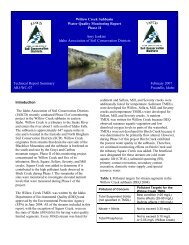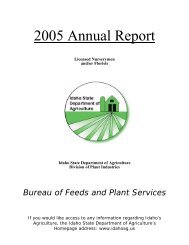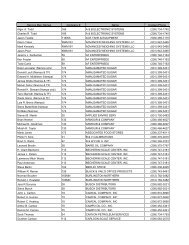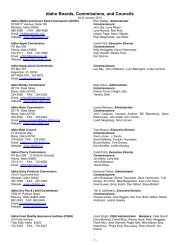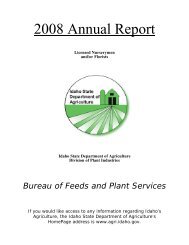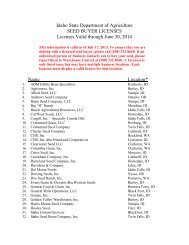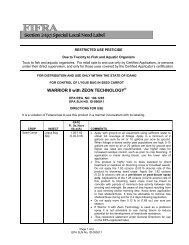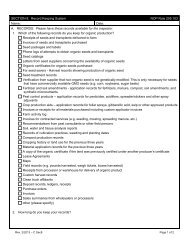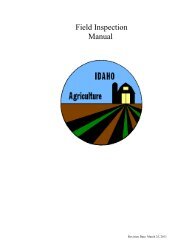2008 Statewide Strategic Plan for Eurasian Watermilfoil in Idaho
2008 Statewide Strategic Plan for Eurasian Watermilfoil in Idaho
2008 Statewide Strategic Plan for Eurasian Watermilfoil in Idaho
Create successful ePaper yourself
Turn your PDF publications into a flip-book with our unique Google optimized e-Paper software.
to amend if they require legal review, while task assignment amendments are operational <strong>in</strong><br />
nature, requir<strong>in</strong>g fewer levels of review. Such contracts would also facilitate EDRR operations.<br />
ISDA Response: Through the development of the <strong>Statewide</strong> EWM Strategy, high priority areas will<br />
be identified. The Aquatic <strong>Plan</strong>ts Program Manager will be tasked with mak<strong>in</strong>g contacts with local<br />
governments and facilitat<strong>in</strong>g local government <strong>in</strong>volvement when it is deemed necessary. ISDA<br />
may consider the use of long-term contracts <strong>in</strong> some situations.<br />
Recommendation 1.6: Fund<strong>in</strong>g allocation flexibility<br />
A percentage of the funds available each year should be held <strong>in</strong> reserve by ISDA to direct toward<br />
high priority problems that may arise dur<strong>in</strong>g the year. The program should rema<strong>in</strong> flexible to allow<br />
<strong>for</strong> additional funds to be allocated to projects when un<strong>for</strong>eseen problems arise that were not<br />
<strong>in</strong>cluded <strong>in</strong> the orig<strong>in</strong>al grant. Likewise, provisions need to be <strong>in</strong> place to expedite the return of<br />
funds if anticipated problems do not arise or do not require the orig<strong>in</strong>ally anticipated fund<strong>in</strong>g level.<br />
Returned funds should then be allocated to areas of greater need. Funds from one fiscal year<br />
should be allowed to be certified <strong>for</strong>ward <strong>for</strong> several weeks or months to pay <strong>for</strong> work completed at<br />
the end of a fiscal year but not <strong>in</strong>voiced until the beg<strong>in</strong>n<strong>in</strong>g of the new fiscal year. Funds not<br />
expended by the end of the fiscal year should be directed to a EWM management trust fund <strong>for</strong><br />
use when conditions are more favorable <strong>for</strong> control. A cap can be applied to the trust fund, so if<br />
funds cont<strong>in</strong>ue to build beyond a prescribed level, they can be redirected to the state’s general<br />
revenue fund or to other <strong>in</strong>vasive species issues. Allow<strong>in</strong>g funds to be certified <strong>for</strong>ward <strong>in</strong> an<br />
established trust fund allows managers to control plants based on science and current conditions<br />
and not on a prescribed adm<strong>in</strong>istrative schedule. Another advantage of the establishment of a<br />
trust fund is to avoid the common perception that herbicide applications are done simply to utilize<br />
funds rema<strong>in</strong><strong>in</strong>g at year’s end to <strong>in</strong>sure receipt of additional fund<strong>in</strong>g the next fiscal year.<br />
ISDA Response: ISDA realizes the value of this flexibility and will consider this recommendation.<br />
Recommendation 1.7: Reimbursement flexibility<br />
While adm<strong>in</strong>istrative-type grants like outreach or education projects can be completed on an<br />
<strong>in</strong>cremental schedule throughout the year, effective EWM management <strong>in</strong> <strong>Idaho</strong> waters seems to<br />
be conf<strong>in</strong>ed to June through August or September; across fiscal years which run from July 1 –<br />
June 30. Future year grant applications may need to be made many months prior to operations;<br />
be<strong>for</strong>e the current year management results have been fully assessed or be<strong>for</strong>e current year<br />
management programs have even been completed. Rather than releas<strong>in</strong>g funds accord<strong>in</strong>g to a<br />
prescribed percentage <strong>for</strong>mula (25% - 50% - 25%), the program should rema<strong>in</strong> flexible allow<strong>in</strong>g<br />
reimbursement after large fund<strong>in</strong>g outlays <strong>for</strong> control. Reimbursements should be considered on a<br />
quarterly or monthly basis especially to entities that received a large grant and have large monthly<br />
expenditures. For example: a county with relatively low <strong>in</strong>ternal fund availability receiv<strong>in</strong>g a million<br />
dollar grant with monthly expenditures of $200,000 dur<strong>in</strong>g the prime control period may need more<br />
frequent reimbursements. Centralized statewide contract<strong>in</strong>g by ISDA <strong>for</strong> herbicides could reduce<br />
the local cash flow impacts and realize significant sav<strong>in</strong>gs.<br />
ISDA Response: ISDA realizes the need to consider alternate reimbursement schedul<strong>in</strong>g,<br />
especially <strong>in</strong> the case of large operational programs. This recommendation will be considered.<br />
Issue 2.0: EWM management program direction<br />
In 2003, the Milfoil Task Force (MFT) <strong>in</strong>itiated a survey of <strong>Idaho</strong> waters to determ<strong>in</strong>e the extent<br />
and cover of EWM. By 2005, EWM was identified <strong>in</strong> 10 of the 44 <strong>Idaho</strong> counties with an estimated<br />
cumulative cover of about 7,500 acres. The MTF estimates that EWM could expand to cover more<br />
than 210,000 acres and recommends immediate action to eradicate EWM where possible and to<br />
reduce or conta<strong>in</strong> EWM where eradication does not seem feasible.<br />
60



